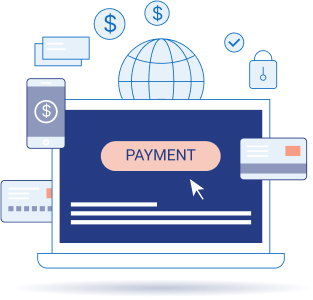All You Need to Know About Payment Processing
In this article
Introduction
In today's dynamic and digitally driven business landscape, seamless payment processing lies at the heart of modern business operations, playing a pivotal role in improving customer experiences and boosting sales. In an era marked by elevated customer expectations, businesses must provide rapid, secure, and seamless virtual payment solutions. Neglecting this requirement can lead to missed opportunities, as customers may opt for competitors offering smoother payment experiences. As companies navigate an increasingly global marketplace, payment processing systems accommodating diverse currencies and preferences become indispensable tools for expansion. In this guide, we’ll unpack what payment processing is and the various methods that businesses can use. We then delve into the payment processing requirements for different types of businesses, the security considerations you should be aware of, and the future trends to keep in mind. We then conclude by discussing the merchant of record role and how ConnexPay can streamline business payment processing.
What is payment processing?
Payment processing is a crucial aspect of modern commerce that enables businesses to accept customer payments using various methods, such as credit cards, debit cards, mobile wallets, and online transfers. Its significance for merchants lies in its ability to facilitate smooth and secure transactions, enhancing customer satisfaction and ultimately driving revenue.
A recent report by Statista has highlighted that the number of e-commerce sales across the world is predicted to surge to a staggering 8,148 billion sales by the year 2026. This revelation underscores the enduring expansion of the online shopping market, reinforcing its sustained growth as a dominant force in the retail landscape.

Payment processing systems facilitate transactions by connecting customers, merchants, and financial institutions. When a customer makes a purchase, their payment details are sent securely to a processor to check the transaction for card validity, available funds, and fraud. If everything is approved, the processor signals the merchant to complete the sale, all in just seconds, ensuring a smooth experience for everyone involved.
The associated transaction processing costs can vary, impacting a business's bottom line, including transaction fees charged by payment processors, interchange fees set by card networks (e.g., Visa and Mastercard, among others), and other service charges. While payment processing is essential for firms, they need to carefully manage these costs to optimize their profitability; some may choose to pass on a portion of these fees to customers or negotiate favorable rates with payment processors to minimize their impact.
Different types of payment providers
Knowing about the types of online payment solutions providers is essential for businesses to make informed decisions, maximize transaction efficiency, and maintain trust with customers. It ensures firms can select the right partners and technologies to meet their specific payment processing needs. Below we detail the various types of payment processors firms should be aware of.
- Acquiring banks: Facilitate businesses in accepting card payments by processing transactions and settling funds.
- Payment service providers (PSPs): Offer a one-stop solution for businesses to accept various payment methods, simplifying integration and management.
- Mobile wallets: Digital wallets like PayPal and Apple Pay allow users to store payment information for convenient and secure online transactions.
- Issuing banks: Provide consumers with credit or debit cards and manage cardholder accounts, authorizing and processing transactions.
- Payment gateway: Securely handle online payment processing by encrypting data and facilitating communication between merchants and banks.
- Reseller: Intermediaries that bundle payment services from providers and offer customized solutions to businesses.
- Commercial banks: Offer financial services, including payment processing solutions, to help businesses manage their finances and operations effectively.
Payment processing methods
Companies need to offer various payment methods to cater to diverse customer preferences. Below, we'll explore the key ways to process payments, each with unique characteristics and advantages.

Card payments
Card payments are a popular and convenient method for online and in-person purchases, offering benefits such as ease of use and transaction record-keeping. These transactions are processed through a secure payment gateway, securely transferring funds from the customer's bank to the merchant's account.
Benefits of card payments:
Card payments, encompassing both debit and credit card processing, offer unparalleled convenience and security to customers. They simplify the purchase process, whether in-store or online, eliminating the need for cash and significantly enhancing sales.
Card transactions also have built-in security features like EMV chips and PIN codes, instilling customer confidence and reducing fraud risks. For businesses, card payments offer the advantage of streamlining checkouts, collecting valuable data insights, ultimately enhancing overall customer experiences, and contributing to improved satisfaction and loyalty.
Limitations of card payments:
A key limitation is the fact that transaction fees can eat into profits, especially for smaller businesses. Furthermore, the possibility of chargebacks exists, potentially leading to financial losses and administrative hassles when customers dispute transactions.
Security can also be a concern, demanding robust cybersecurity measures to safeguard cardholder data. Moreover, it's crucial to recognize that not everyone has access to card payments, therefore, different options should be provided to serve a diverse customer base.

Contactless payments
A 2023 Statista report stated that Between 2022 and 2026, an estimated three million more people in the UK are expected to embrace mobile wallets in stores. This growth underscores the remarkable significance and accelerated adoption of contactless payment technology such as Apple Pay and Google Pay over just eight years, driven by the growing popularity of smartphones and the desire for faster and more secure transactions.
Benefits of contactless payments:
Contactless payments provide convenience and speed, making transactions faster and more efficient. Customers can simply tap their contactless cards or mobile devices on a compatible reader, eliminating the need to insert cards or count out cash.
This speed is especially valuable in situations where time is of the essence, such as during rush hours, at crowded events, or when making quick purchases. Additionally, contactless payments reduce the need for physical cash, which can be lost or stolen, and they also minimize the risk of spreading germs through the exchange of bills and coins, a particularly important advantage during health crises like the COVID-19 pandemic.
Limitations of card payments:
While contactless transactions are generally considered secure, there is a small risk of unauthorized transactions if someone gets hold of your card or device. To mitigate this, many systems have implemented transaction limits and require occasional PIN verification.
Another limitation is that not all merchants and businesses support contactless payments, which means that users may still need to carry physical payment methods for places that do not offer this option. Additionally, there are concerns about the potential for data breaches or privacy issues when using mobile payment apps, as they may collect and store personal information.

E-commerce payment gateways
A payment gateway is a digital service that serves as the intermediary between an online store and a financial institution, facilitating online transactions by securely transmitting payment information between the customer, the merchant, and the bank. Unlike brick-and-mortar stores, online businesses rely on secure payment gateways to ensure the security of online payments, encrypting sensitive data to protect it from potential cyber threats, fraud, and unauthorized access, given the more vulnerable nature of online transactions compared to physical, in-person purchases.
There are three primary types of e-commerce payment gateways:
1. Hosted:
Hosted gateways are third-party services that handle the entire payment process on their servers. Customers are redirected to the gateway's secure page to enter their payment information. This option is convenient for merchants as they don't need to handle sensitive data, but it may result in a less seamless checkout experience.
2. Self-Hosted:
Self-hosted gateways allow merchants to collect and process payment information directly on their websites, providing a more integrated user experience. While they offer greater control and customization, they also require more responsibility for security and compliance with payment industry standards such as PCI DSS (Payment Card Industry Data Security Standard), making it vital for businesses to maintain rigorous security protocols and regulatory compliance.
3. API-Based:
API-based gateways offer a balance between control and convenience, integrating directly with a website's checkout process, and providing flexibility and customization while maintaining the security of sensitive data. Merchants can design their payment pages while relying on the gateway's backend infrastructure for processing.
Each type has advantages and considerations, and the choice often depends on factors like the level of technical expertise, security requirements, and the desired user experience of the e-commerce business.
Benefits of payment gateways:
Payment gateways enhance security by encrypting and safeguarding sensitive customer payment information, reducing the risk of data breaches and fraud—critical in the digital age where online transactions face constant cyber threats. They also broaden businesses' customer base by accepting various payment methods, from credit cards to digital wallets and even international currencies.
Payment gateways, essential components of virtual payment solutions, can facilitate real-time transaction processing, ensuring swift and efficient payments that enhance the overall shopping experience and customer satisfaction. They often come with features like automated recurring billing and seamless e-commerce platform integration, streamlining transaction management and reducing administrative burdens.
Limitations of payment gateways:
One notable limitation of payment gateways is the cost associated with using these services, as businesses typically pay fees for each transaction and may incur setup and monthly subscription costs. Additionally, some payment gateways may have limitations on the types of products or services they support, which can be a challenge for businesses with specialized offerings.
However, despite a few considerations, overall payment gateways are invaluable assets for e-commerce businesses. While there are associated costs, these fees are a small investment compared to the security and convenience they provide, ensuring the protection of customer payment data, helping businesses build trust with their clientele, and protecting their reputation.

Automated clearing house (ACH) transactions
ACH transactions are electronic fund transfers in the United States, enabling direct deposits, bill payments, payroll, and other electronic payments. ACH is a key player in modern finance, providing a cost-effective and efficient way to electronically transfer money, and reducing the need for checks and cash. Additionally, ACH transactions are overseen by NACHA, setting the rules and standards to ensure their smooth and secure operation.
Benefits of ACH transactions:
ACH transactions offer numerous advantages, with cost-effectiveness and efficiency standing out prominently. These transactions come with low processing costs, making them a cost-efficient choice for both individuals and businesses, especially when compared to pricier alternatives like wire transfers or credit card transactions.
ACH transactions are also highly efficient, allowing for seamless automation of fund transfers between bank accounts. This automation translates to quicker processing times for routine payments, such as direct salary deposits and recurring bill payments, resulting in time savings and reduced administrative overhead.
Limitations of ACH transactions:
One notable limitation of ACH transactions is the potential for longer processing times than other payment methods, especially for larger transactions involving multiple banks. Additionally, transactions are primarily intended for domestic transfers within the United States, making them less suitable for international transactions.
Lastly, ACH transactions demand accurate bank account information, and any errors in account numbers or routing codes can result in delays and complications in the payment process. Such hiccups can have a tangible impact on the customer experience, making accuracy and attention to detail paramount when using ACH transactions.

Cryptocurrency payments
Cryptocurrency payments are gaining traction due to their appeal as a decentralized and borderless digital currency, which offers security and transparency through blockchain technology. Increasing adoption by businesses, financial institutions, and investors, along with growing awareness and acceptance, has fueled the widespread use of cryptocurrencies for various financial transactions, investments, and even as a store of value.
Benefits of cryptocurrency payments:
First and foremost, cryptocurrency payments significantly reduce the risk of fraud due to the cryptographic security measures inherent in blockchain technology. This makes it incredibly challenging for unauthorized parties to tamper with or counterfeit cryptocurrency transactions, enhancing security for both consumers and businesses.
Cryptocurrency transactions also often entail lower fees compared to traditional financial systems, particularly when it comes to international transfers. This is especially valuable for cross-border transactions, as it sidesteps currency conversion fees and the involvement of intermediaries like banks.
Furthermore, cryptocurrencies provide the opportunity for borderless transactions, streamlining international trade and remittances by bypassing the typical bureaucratic hurdles associated with traditional banking systems. They are a more direct and efficient means of conducting cross-border transactions, making it easier for businesses to engage in global business and for individuals to send and receive money across borders quickly with reduced fees.
Limitations of cryptocurrency payments:
A notable limitation of cryptocurrency payments is that their price volatility can be a double-edged sword. While it has the potential for significant gains, it also poses the risk of substantial losses due to rapid value fluctuations. This can introduce uncertainty and challenges for both merchants and consumers who rely on stable currencies for everyday transactions.
Additionally, not all businesses and vendors embrace cryptocurrencies as a payment method, which often necessitates converting cryptocurrencies back into fiat currency for practical use in various transactions. This underscores the ongoing need for greater adoption and integration of cryptocurrencies into the broader economy.
Payment processing requirements for different businesses
It's essential to acknowledge that various types of businesses have distinct payment processing needs, which can vary significantly based on factors such as industry, size, and geographic reach. Understanding these differences is crucial for tailoring payment processing solutions that align with the specific demands of each business, ultimately enhancing efficiency and customer satisfaction. Below we delve into the various payment processing requirements for different types of online businesses.

Payment processing for small & mid-sized businesses
Small and mid-sized online businesses have distinct payment processing needs compared to larger enterprises. These needs often revolve around factors like affordability, ease of setup, and compatibility with various online platforms which are discussed below:
- Affordability: Small and mid-sized businesses often operate on tighter budgets than larger corporations. Therefore, they require cost-effective payment processing solutions that don't eat into their profit margins. Such firms should look for payment providers with competitive pricing structures, including reasonable transaction fees and monthly subscription costs.
- Ease of setup: Time is of the essence for smaller businesses as they can't afford long and complicated onboarding processes. They need payment solutions that are easy to set up and integrate into their existing e-commerce platforms or websites. User-friendly interfaces, clear documentation, and responsive customer support are crucial elements for these businesses.
- Compatibility with online platforms: A variety of e-commerce platforms, such as Shopify, WooCommerce, BigCommerce, or custom-built websites are typically utilized by small and mid-sized businesses. Payment processors must seamlessly integrate with these platforms to facilitate smooth transactions avoiding lost sales.
- Security and fraud protection: Small and mid-sized businesses need payment processors that offer robust security features, including encryption, tokenization, and fraud detection. Protecting sensitive customer data is vital to maintain trust and avoid potential legal issues.
- Scalability: As small businesses grow, they need payment solutions that can scale with them. Scalable payment processors should allow for increased transaction volume without significant disruptions or additional setup costs to accommodate growth.
- Mobile optimization: With the increasing use of mobile devices for online shopping, payment processing solutions must be mobile-friendly. Small and mid-sized businesses should look for options that offer responsive mobile checkout experiences and support various mobile payment methods.
Overall, small and mid-sized businesses face distinct payment processing requirements tailored to their unique circumstances including affordability, ease of setup, compatibility with online platforms, security and fraud protection, scalability, and mobile optimization. Meeting these essential criteria not only enables such firms to efficiently manage their payment processes but also positions them for growth and success in the competitive business landscape.

Payment processing for e-commerce businesses
E-commerce businesses, whether startups or established enterprises have unique payment processing requirements that set them apart from other online ventures. These specialized needs are centered on aspects such as international transaction capabilities, robust fraud prevention, and seamless integration with shopping carts and inventory management systems.
Payment Ecosystem
The e-commerce payment ecosystem is a critical component of online businesses, encompassing various elements essential for seamless and secure transactions. Together, the following components form the backbone of a successful and secure e-commerce payment ecosystem, enabling businesses to operate efficiently while prioritizing customer trust and security.
- Fraud prevention: Fraud prevention is paramount in e-commerce due to the increased risk of online fraud. Businesses should invest in advanced fraud detection systems and machine learning algorithms to identify and prevent fraudulent transactions, safeguarding both the business and its customers.
- Payment card industry data security standard (PCI compliance): This involves robust security measures to protect cardholder data and maintain trust. Online businesses undergo regular security assessments and audits to meet these standards, ensuring the safety of payment processing.
- Integration with shopping carts and inventory management systems: This integration ensures real-time inventory updates and an efficient checkout process for customers, streamlining the shopping experience. Compatibility issues can result in lost sales and operational inefficiencies, making it vital for firms to maintain a seamless connection between their payment systems, shopping carts, and inventory management tools.
International transactions
International transactions can be challenging when selling online due to the need to manage currency conversion, comply with varying tax laws, and navigate complex regulatory requirements, making it crucial for businesses to ensure seamless cross-border payment processing. The following complexities can impact pricing accuracy, legal compliance, and customer satisfaction.
- Currency conversion: Online businesses operating globally must provide customers with the option to view prices and make payments in their local currency, which often requires integrating with currency conversion services or payment gateways that offer multi-currency support. Additionally, managing exchange rate fluctuations is crucial to ensure pricing consistency.
- Tax considerations: Firms that sell online must understand and comply with various tax laws, including value-added tax (VAT) or goods and services tax (GST) in different countries. This may require tax calculation tools integrated into their payment systems to ensure accurate tax collection and reporting.
- Legal and regulatory compliance: International e-commerce operations need to adhere to diverse legal and regulatory requirements across jurisdictions. This includes data privacy laws like GDPR in Europe and consumer protection laws. Non-compliance can lead to legal repercussions and damage a company's reputation.
- Shipping and logistics: Handling international transactions entails logistical challenges, such as managing shipping costs, delivery times, and customs documentation. Online sellers must offer transparent shipping options, including tracking, and communicate potential customs duties or import taxes to customers.
Overall, e-commerce businesses have distinct needs in terms of the payment ecosystem and international transactions. They require robust fraud prevention measures, compliance with PCI standards, seamless integration with shopping carts and inventory systems, and solutions for currency conversion, tax considerations, and legal compliance when conducting international transactions. Meeting these requirements is essential to ensure a secure and smooth online shopping experience for customers and the successful expansion of operations across borders.
Head to our content offer to learn more about how to overcome issues in multinational payments.

Payment processing for online retail stores
Payment processing needs for online retail stores are vital for providing a seamless and secure shopping experience for customers while streamlining operations for businesses. Below we discuss these specific requirements:
Payment Ecosystem
The e-commerce payment ecosystem is a critical component of online businesses, encompassing various elements essential for seamless and secure transactions. Together, the following components form the backbone of a successful and secure e-commerce payment ecosystem, enabling businesses to operate efficiently while prioritizing customer trust and security.
- Payment gateway integration: Online retail stores must integrate with dependable payment gateways to securely process transactions. These gateways should support various payment methods, including credit/debit cards, digital wallets such as PayPal and Apple Pay, and alternative payment options such as Klarna. Ensuring compatibility with a wide range of payment preferences enhances customer convenience and can boost conversion rates.
- Security and fraud prevention: In online retail, robust security measures are required, including encryption protocols (e.g., SSL) for securing payment transactions. Moreover, online retail stores often employ AI-driven fraud detection systems to identify and mitigate potentially fraudulent orders, safeguarding both the business and its customers. Complying with data protection regulations, such as the PCI DSS, is also essential to prevent data breaches.
- Mobile optimization: With the growth of mobile shopping, online retail stores must prioritize mobile optimization. Payment processing systems should offer a seamless mobile checkout experience, with responsive design and user-friendly interfaces, as many customers shop using smartphones and tablets.
- Subscription and recurring billing: For businesses offering subscription services or products with recurring billing, a flexible payment processing system that supports automated billing and subscription management is essential. This ensures the hassle-free renewal of subscriptions and reduces churn rates.
- International payment capabilities: Online retail stores looking to expand globally need to facilitate international transactions efficiently. This involves currency conversion support, multi-language interfaces, and adherence to international tax regulations, including VAT and customs duties.
- Payment analytics: To optimize their sales and marketing strategies, online retail stores require access to payment analytics and reporting tools. These insights help businesses track transaction trends, customer behavior, and the effectiveness of marketing campaigns, enabling data-driven decision-making and improved revenue generation.
Payment processing needs for online retail stores encompass various aspects, from payment gateway integration and security measures to mobile optimization and international payment capabilities. Meeting these requirements is essential for providing customers with a convenient and secure shopping experience while enabling businesses to effectively manage their online sales operations.

Payment processing for B2B transactions
Business-to-business (B2B) online transactions come with distinct payment processing requirements that cater to the specific needs of organizations. Two crucial aspects to consider are invoice-based transactions and flexible payment terms:
- Invoice-based transactions: Efficient invoicing and payment tracking systems are vital in B2B e-commerce, requiring detailed invoices and robust tools for processing and tracking them. Automated tools for invoice generation, delivery, and reconciliation can significantly streamline this process, reducing manual errors and accelerating the payment cycle.
- Flexible payment terms: B2B transactions commonly involve flexible payment terms which offer cash flow management flexibility and support strong business relationships. Payment terms can also be tiered or milestone-based, adding complexity to payment arrangements. Therefore, implementing a payment processing system that can adapt to these diverse arrangements is vital for successful B2B e-trade.
Overall, B2B transactions stand apart due to their reliance on invoice-based transactions and the flexibility of payment terms, which accommodate the unique dynamics of business-to-business transactions. Implementing efficient invoicing and payment tracking systems, along with adaptable payment term options, is essential for fostering trust and facilitating smooth transactions in the B2B landscape.
Security considerations for payment processing
Ensuring payment security, especially within the realm of online payment solutions, is paramount in safeguarding both businesses and customers in an increasingly digital world. Below, we delve into the key payment security considerations in greater detail to help businesses protect against fraud and data breaches.

- Use secure online payment technology: Employing robust encryption methods and secure socket layer (SSL) technology is essential. This ensures that sensitive payment data is protected during transmission. Additionally, consider implementing tokenization to replace card details with tokens, adding an extra layer of security.
- Ensure PCI DSS compliance: Compliance with the Payment Card Industry Data Security Standard (PCI DSS) is non-negotiable. Regularly assess and maintain security measures to protect payment card data, including encrypting data, restricting access, and conducting security audits.
- Educate employees on scams and cybersecurity best practices: Educate employees about phishing, social engineering, and the importance of strong password practices. Encourage a culture of vigilance and empower them to recognize and report suspicious activities.
- Regularly monitor and analyze transactions: Real-time transaction monitoring helps detect and prevent fraudulent activity. Automated systems can flag unusual patterns, enabling timely intervention and reducing potential financial losses.
- Partner with payment solutions providers (PSPs): Collaborating with reputable PSPs offers an added layer of security as these providers often have advanced fraud detection tools and expertise in handling secure transactions. Ensure your chosen provider follows industry best practices and security standards.
- Implement two-factor authentication (2FA): Require customers to use 2FA for added security during payment processing. This extra layer of verification, like receiving a code on a mobile device, significantly reduces the risk of unauthorized access to accounts.
By addressing these security considerations, businesses can strengthen their payment processing systems against threats and enhance the overall security of online transactions.
Future trends in payment processing
The following trends represent significant advancements in payment technology, aiming to enhance security, convenience, and efficiency for both businesses and consumers. They reflect the ongoing evolution of payment systems in response to the demands of our increasingly digital and interconnected world.
- AI and machine learning: AI and machine learning are revolutionizing payment technology, particularly in risk management and fraud detection. These technologies can analyze vast amounts of transaction data in real-time, identifying patterns and abnormalities that may indicate fraudulent activity. They enhance security by continuously adapting to evolving threats and improving the accuracy of transaction verification
- Biometric authentication: Biometric authentication methods, such as fingerprint scanning, facial recognition, and iris scanning, are becoming increasingly prevalent in payment systems. These technologies provide a highly secure and convenient way for users to authenticate their identity, reducing reliance on passwords and PINs, which reduces identity theft and unauthorized access.
- Blockchain and cryptocurrency: Blockchain technology is disrupting traditional payment systems by providing a decentralized and secure ledger for transactions. Cryptocurrencies like Bitcoin and Ethereum, built on blockchain, offer efficient and transparent peer-to-peer payment methods. They also enable cross-border transactions with lower fees and reduced reliance on intermediaries, potentially revolutionizing international payments and remittances.
ConnexPay's payment processing solutions
ConnexPay stands out as the first and only all-in-one payment solutions provider to link incoming customer payments to outgoing supplier payments within a unified platform, seamlessly and instantly, without the need for credit lines or upfront reserves. By choosing ConnexPay as their trusted partner, businesses can streamline their payment operations, reduce costs, and enhance their overall financial management.

Why choose ConnexPay?
Business-to-business (B2B) online transactions come with distinct payment processing requirements that cater to the specific needs of organizations. Two crucial aspects to consider are invoice-based transactions and flexible payment terms:
- Comprehensive payment solutions: ConnexPay offers a wide range of payment processing services, including payment acceptance and disbursement capabilities. This comprehensive approach eliminates the need to manage multiple payment providers, streamlining operations and reducing administrative overhead.
- Enhanced security and fraud prevention: ConnexPay places a strong emphasis on security, protecting sensitive financial data with advanced encryption and fraud prevention measures. This ensures the safety of both incoming and outgoing payments, bolstering trust and compliance with industry standards.
- Efficiency and cost savings: By consolidating payment processes into a single platform, ConnexPay significantly reduces transaction costs and minimizes the risk of errors. This efficiency translates into time and cost savings for businesses, enabling firms to focus on core operations.
- Global reach: ConnexPay's solutions are designed to facilitate both domestic and international payments, making it ideal for businesses with a global presence. It supports multiple currencies and payment methods, allowing for seamless cross-border transactions.
- Robust reporting: ConnexPay provides businesses with advanced reporting and analytics capabilities, enabling them to gain valuable insights into their financial transactions. This data-driven approach empowers businesses to make informed decisions and optimize their payment processes.
- Simplified integration: ConnexPay offers easy integration options with existing systems and platforms, making it accessible for businesses of all sizes. This minimizes disruptions during implementation and ensures a smooth transition to their payment solutions.
- Real-time access to incoming customer funds: With ConnexPay, businesses experience no waiting for payments to settle, eliminating the need for a line of credit. Immediate access to incoming customer funds ensures streamlined cash flow management.
- Improved cash flow management: ConnexPay empowers businesses with improved cash flow management. Firms can seamlessly utilize incoming customer funds to make outgoing supplier payments, all within the same platform, ensuring efficient financial operations.
Summary
In this extensive payment processing guide, we've explored the ever-evolving landscape of financial payments technology, covering a spectrum of trends and advancements. We discussed the significance of payment security, diverse payment processing providers, and various methods. We then outlined payment processing needs for different businesses and highlighted essential security considerations for safeguarding transactions in today's digital landscape.
Finally, we introduced ConnexPay as a trusted all-in-one payment solutions provider, emphasizing its unique features such as comprehensive services, heightened security, operational efficiency, and global accessibility. For businesses seeking to transform their payment processes, ConnexPay is the ideal partner.
Embrace the future of payments with ConnexPay and unlock new levels of success for your business. Contact us today to embark on a journey toward simpler, safer, and more efficient payment processing.